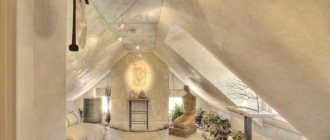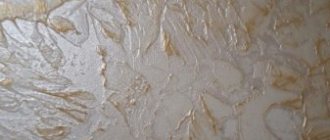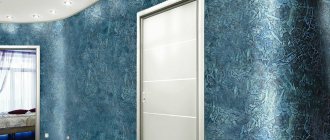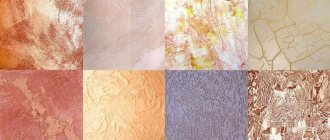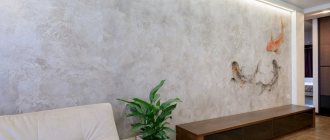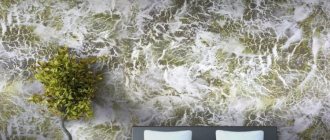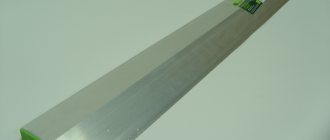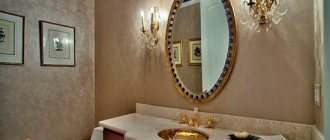Venetian plaster is an ideal way to cladding walls to look like polished marble. Forget about banal wallpaper - be closer to Italy! Venetian plaster in the bedroom, office or kitchen - it always gives an elegant and chic look to any room, has a “delicate” texture, shimmers in the light and hides any surface imperfections. Have you watched how marble or granite shimmers? What about noble onyx or jasper? Believe me, this wall covering is much more beautiful than wallpaper, because it contains Italian charm, luxury and aesthetics! Venetian plaster for interior decoration is suitable in all respects.
What is Venetian plaster and its composition
If the wall in appearance resembles a marble surface, but there are no seams on it, it is finished with Venetian plaster. This finishing material was invented centuries ago in Ancient Rome. When someone came up with the idea of mixing marble dust and slaked lime. The result was an elastic composition that looked like natural marble on the walls. For a clearer pattern, natural dyes were added to the mixture.
Venetian plaster is applied to walls, ceilings, columns
The most popular was clay. The walls had reddish or pinkish (depending on the color of the clay) stains, which made the decoration more similar to natural marble. To make the coating durable, the plastered surface was covered with a layer of wax, which was then polished. The walls were indistinguishable from marble. Only there were no seams.
And only centuries later, during the Renaissance, Venetian plaster appeared in Venice, where it began to be used instead of marble slabs. The technique for applying it was not simple, but working with Venetian plaster is much easier than adjusting and polishing marble slabs. Therefore, this type of finishing has become very popular. It was used to decorate walls, ceilings, and columns in palaces. The finish was beautiful and durable, and did not respond well to changes in humidity and temperature, which, in the high humidity of Venetian canals, led to literally widespread use of this material. The popularity was also facilitated by the fact that marble dust is easier to import and is cheaper. The remaining components were added locally mined. The fame of this beautiful finishing material quickly spread among merchants, and they called it Venetian plaster. Since then it has been like this.
Decorative Italian plaster can be light or rich in color
The composition of Venetian plaster described above - marble dust, slaked lime and coloring additives - is still used today. Absolutely natural finish. But there are compositions in which synthetic dyes (acrylic) are added or modern binders are used instead of lime. There may also be sap from rubber trees, crushed granite. Whether all or some additives are contained depends on the manufacturer, but this material is also called Venetian plaster, since the main component - marble dust - remains the same.
Composition of the Venetian
Since antiquity, the composition of the material has not changed much: stone chips are bound with a special substance, then a dye is added to enhance the resemblance to stone. The putty consists of 100% natural materials, is hypoallergenic, and breathable.
Binder
First, slaked lime or acrylic compositions are used to prepare the plaster. The mixture with the latter dries faster. The manufacturing principle is the same: mix with stone dust, add pigment. If the end result resembles marble without joints or seams, then the composition is the same as that sold in stores.
Stone chips
Initially, the coating replaced marble due to its cost. Modern technologies solve more problems. Crumbs are made not only from marble, but also from granite, onyx, quartz and malachite.
The coarser the grind, the greater the wall roughness effect.
The finer the stone dust particles, the smoother the wall surface will be. Coarse grinding creates the effect of rough, hewn stone.
Dye
The pigment enhances the resemblance of plaster to natural stone. Popular tones are natural: white and gray, brown, green. Dyes in the 21st century. remain natural, but help make the shade rich or muted, soft. To create a pearly shine, mother-of-pearl particles are added to the composition.
The journey of Venetian plaster to Russia
The Venetian woman gained particular popularity in the romantic but “raw” city of Venice. Numerous canals repeatedly flooded its facades, and high humidity contributed to fungal infection. Residents needed to decide: what to cover the walls of their houses with in order to protect them from the formation of mold. It turned out that there is no better material than lime plaster, and the low cost of the composition made it possible for people with different incomes to buy it. For Moscow and central Russia, Venetian is more of a decorative plaster for interiors, rather than for facades. Today, buyers have the opportunity to purchase both classic Venetian plaster, the composition of which has not changed for several centuries, and acrylic - rich in improving ingredients, but with some differences.
Care: how to wash and clean
The wax coating will protect the plaster from moisture
For the first 2 months after applying the plaster to the wall, it cannot be washed, since the coating will finally harden only after the specified time. For 2 months, Venetian plaster must be protected from moisture, dirt and water splashes. When this period has expired, you can wipe the coating with a damp cloth or sponge. To care for the finish, you can use mild detergents that do not contain solid particles or caustic chemical components.
Properly applied Venetian plaster will last for many decades, during which it will not lose its decorative effect and will not require repairs. Periodic maintenance and renewal of the wax layer will ensure the preservation of the appearance of the finish.
The battle between classics and acrylic: which is better?
What kind of material to buy for wall decoration depends on the designer’s idea, budget and client’s wishes. For a coating that has the maximum resemblance to a natural marble surface, you need classic Venetian plaster with air-lime, which is applied to previously prepared and carefully leveled walls (by eliminating defects, sanding, covering with putty, and then impregnating). Such work is sometimes carried out by a master of artistic design, who draws in detail the original marble patterns, down to barely noticeable veins. Of course, the services of an artist will increase the cost of finishing work. If the ideal accuracy of reproducing the marble texture is not important, then it is better to buy acrylic decorative plaster. Made from environmentally friendly water-based latex, it has the same strength characteristics as its limestone counterpart. And together with protective wax, the coating becomes invulnerable to moisture, so it is used for finishing walls in damp rooms - bathrooms, showers, etc.
Necessary tools, consumption calculation
Before starting work, you need to prepare the necessary tools
The consumption of plaster coating is easy to calculate, since similar information is indicated on the product packaging. If we are talking about a simple leveling mixture, the information in the instructions may not coincide with reality, since there are irregularities, depressions, and roughness on unprepared walls. With Venetian plaster the situation is simpler, because it is used in finishing and applied to carefully leveled walls.
To calculate the approximate consumption of Venetian plaster, you need to pay attention to the following factors:
- the area of the walls to be covered;
- the number of layers that will be applied to the base during the work process;
- thickness of one layer - the recommended value is indicated on the packaging of the plaster mixture.
To work with Venetian plaster, in addition to the finishing composition itself, you may need the following materials and tools:
- primer for preliminary preparation of walls;
- wax to create a protective coating on plaster;
- spatulas of different widths;
- trowel;
- suede leather;
- damp sponge or rag;
- construction mixer;
- containers for plaster, primer, water.
Golden glow or noble mother of pearl
Venetian-decorated walls become mirror-smooth. You can never achieve a similar effect with paint or wallpaper. The texture design is always exclusive, because the wall is created spontaneously, at the hand of the master. Overlapping each other, several thin translucent layers create a fantastic, unique pattern:
— Veneto – classic Venetian plaster, made with the best lime, aged for 36 months after slaking. This makes the finish unsurpassed in hardness and beauty of the pattern.
— Encausto – for an impeccably smooth, artistic “marbled” finish with piquant terracotta ripples.
— Imperiale – to give the walls a delicate, sophisticated golden shine. An inexpensive way to showcase luxury walls.
— Marbella – to recreate the antique roughness of marble. A luxurious illusion of imperfection for a perfectly even finish.
— Marmorella – to give surfaces a calm and self-sufficient matte finish, an optical trap for fans of polished stone. The price of such a coating, unlike marble, will be low.
— Tierrafino – the nobility of subtle mother-of-pearl shimmer combined with the surface, rough processing of marble - visible, but intangible.
— Trevignano – the radiance of immaculately polished marble, in which, like in a mirror, silhouettes and interior items are reflected.
Advantages and disadvantages of finishing rooms with Venetian plaster
Venetian plaster has both those who love to use the material in their projects and those who are not satisfied with this plaster due to its disadvantages. Admirers of the material justify their choice with the following advantages:
- Good wear resistance - lasts 10 years, some say that even 15 is not the limit for the preservation of the interior in its original form. Cracks almost never appear on such a surface.
- Environmental friendliness - even artificial additives in the composition of Venetian plaster do not pose any danger to human health.
- If necessary, the coating is quite easy to restore.
- Aesthetics - this coating is the best analogue of marble, granite surfaces and other stone textures.
As a disadvantage of Venetian plaster, many highlight the fact that it is more expensive than most other options for finishing materials. At the same time, for the result to look aesthetically pleasing, the composition must be applied correctly. And the putty technique involves multi-layering. Therefore, working with Venetian plaster is difficult and troublesome.
Why is she popular?
This type of plaster very skillfully reproduces the imitation of natural stones - marble, granite and other expensive rocks. This type of finishing was invented in ancient Rome and for more than two centuries continues to be popular as the most sophisticated and expensive. It is characterized by some pomp, so Venetian plaster is not suitable for every interior.
It looks most appropriate in spacious living rooms or bedrooms, salons, swimming pools and offices; this is a kind of sign of luxury. If the room is small, then it is better to limit yourself to partial decoration in the Venetian style.
Where is it used?
It is used when carrying out finishing work indoors as a finishing surface. It covers walls and ceilings and is used for partial decoration - finishing cornices, columns, fireplaces and other interior elements. The facade cannot be decorated with it, because it cannot withstand direct exposure to water and constant temperature changes. But it is resistant to moisture, it is used for plastering bathrooms, toilets, baths and swimming pools.
Plaster or wallpaper - what to choose
What is better - Venetian plaster or wallpaper depends on the room. In standard living rooms with low ceilings it will look too pretentious. It is more rational to make a choice in favor of wallpaper.
Instagram @stucco_italiano_sweden
The Venetian fits perfectly into large rooms, hotels, galleries of public buildings, cafes, restaurants and expensive reputable offices. It goes well with almost all styles, be it vintage, rococo, empire or even high-tech.
Types of Venetian
There are several varieties of Venetian, differing in appearance, composition and method of application.
Craquelure
It has an antique effect and features intricate patterns with cracks. This decorative technique is achieved through a special craquelure varnish, which, when dried, tightens the plaster layer and forms fractures.
Carrara marble
To achieve an imitation of Carrara marble, several layers of plaster are applied, differing from each other by half a tone. The result is a rather expensive finish that plays with a variety of tints.
The photo shows walls decorated with Venetian plaster with the effect of Carrara marble.
Veneto
It has a semi-matte surface with the effect of polished marble. This design option will undoubtedly give the room nobility and aristocracy.
Marseille wax
This unusual visual effect is obtained due to the addition of wax, which not only transforms the appearance of the entire coating and adds additional chic to it, but also improves its technical characteristics, for example, this finish can be used in rooms with high humidity levels.
Trevignano
Thanks to layers of different colors, this surface has iridescence and a special play of light. Using a polymer mixture and a certain application technique, an imitation resembling the travertine rock is obtained.
The photo shows Venetian Trevignano plaster on the wall in the dining room.
Marbello
This texture looks very elegant and expensive; in appearance it looks like velvet with streaks of gloss. Marbello can also change shade depending on the lighting angle.
Encausto
Dark matte surface that resembles granite. Using a finishing wax coating can further enhance this effect.
Photo of plaster in the interior of rooms
Photos using Venetian in various interiors.
Bedroom
Venetian decorative plaster is environmentally friendly and non-toxic and therefore is an almost universal option for the bedroom. Thanks to a wide color palette, this design will give the room airiness, individuality and chic.
Children's room
A safe and harmless Venetian will help you decorate the nursery, both in bright and rich colors, and in calm and delicate colors. The plaster mixture is considered a self-sufficient finishing element, which significantly transforms the room and makes it much more impressive.
Living room or hall
With this unique wall decoration, which has a special structural character, you can achieve a variety of effects on the ceiling or walls. For the living room, classic plaster, silk, velvet, concrete or travertine surface are suitable.
In the kitchen
A plaster mixture with a special finishing coating allows you to create a luxurious design even for the kitchen or dining room. This coating is very easy to care for and is not susceptible to fungus and mold.
Hallway and corridor
The Venetian will be an excellent decoration for the corridor, and thanks to its expressive tints, highlights or matte touches it will give it a certain charm.
Bathroom
Here, the most even and smooth textures that will not accumulate dirt and dust will be more appropriate. A protective varnish layer, iron or wax enamel, will help reduce maintenance to a minimum.
Balcony
Such a durable and practical design will give the balcony space incredible expressiveness and volume. Various color options and natural patterns will create an unusual play of light in a given room.
Toilet
Venetian not only adds artistry and sophistication to the bathroom, but also perfectly withstands temperature changes, humidity and retains its decorative qualities for a long time.
Types of decorative coatings
The main types of Venetian coating.
Natural (classic)
This variety is applied using the traditional multi-layer method. Classic Venetian plaster contains marble chips, binders and various additives that provide good strength properties.
Imitation or what to replace
Plaster imitation options.
Wallpaper
They perfectly imitate the Venetian and allow you to get an equally attractive result without extra costs and complicated application.
Tension fabrics (for ceilings)
Tension products with such imitation are particularly beautiful and sophisticated, but they are a rather unusual and not yet very common interior solution.
Panels
Lightweight panels are easy to install, perfectly hide surface unevenness and are in no way inferior to the original in appearance.
The photo shows wall panels with an imitation of a plastered surface.
Tile
It combines well with a variety of materials and is resistant to mechanical stress and temperature changes. The tiles perfectly imitate stones, such as pink or amber onyx, gray granite or deep green malachite.
DIY interior wall decoration
There are no problems for masters in how to make Venetian plaster with your own hands and then apply it to prepared walls; sometimes even a beginner can cope with this task.
But you should take into account some of the nuances of making this type of decorative coating yourself:
- the use of polymer and synthetic binder components is quite justified, since they impart higher performance characteristics to such a coating;
- Natural, most often mineral, dyes can also be replaced with artificial substances;
- The constant component remains marble or other chips, which can be purchased in many stone processing shops.
Venetian plaster blue
But the real apologists of this plastering art believe that the real “Venetian” is an exclusively natural composition. Only in this case, in their opinion, can one truly feel and see all the beauty of the stone.
For interior wall decoration, modern industry offers ready-made compositions in containers from 5 to 25 kg, which before starting work should only be thoroughly mixed and, trusting your artistic instinct, get to work.
In this video they will tell you how to apply Venetian plaster with your own hands and introduce you to its features.
What you need to know about Venetian plaster
- The polished marble effect can be achieved with any type of Venetian plaster. If you choose a lime-based material, it is better to have it applied to the walls by a qualified craftsman.
- The pattern of polished marble fits into any architectural and interior style. However, keep in mind that smooth polished walls will make the room cold and uncomfortable.
- Before applying Venetian plaster, you need to prepare the surface. The wall should be free of cracks, scratches and stains.
- To apply Venetian plaster, you will need a primer, a backing, the material itself and wax - all from the same manufacturer, as well as a trowel.
- Acrylic Venetian plaster is easier to restore. To give it a fresh shine, you can apply wax and repeat the polishing procedure.
Advantages and disadvantages
Venetian plaster has strengths and weaknesses that need to be considered when purchasing.
Advantages
- Moisture resistance. A layer of wax is applied on top of the finished coating, which repels moisture. Sometimes it is included in the composition. Subsequently, you can wet clean the surface.
- Environmental friendliness. Contains artificial polymers, but this does not make the mixture toxic. Contact with her is absolutely safe.
- Resistance to physical impact. No cracks or scratches appear on it, it does not deform or crumble. With proper care, it will last 10-15 years or more without repair.
- Rich color palette. Any shade can be prepared. Only a professional can predict what the final color and pattern will be. He can create an unusual effect by adding various dyes to the source material.
- Easy to dismantle. The surface is easy to repair. The places where the old coating transitions to the new one are invisible.
- Vapor permeability. No condensation forms on the walls.
- Fire resistance. There are no fire hazardous components in the composition. The solution can withstand fairly high temperatures - up to 75-80°C.
Flaws
- Expensive. This material is produced from natural raw materials, which always costs more than artificial polymers. Moreover, experts advise not to skimp on protective equipment.
- Labor intensity. Laying is carried out in 3-10 layers strictly according to technology. Before this, you need to carefully prepare the rough surface. It must be perfectly smooth and clean, otherwise unevenness will be visible. The work will take a lot of time and effort.
- Difficulty in preparing the mixture. It is very difficult to obtain a certain color effect or create an interesting pattern or design. Only a person with the appropriate knowledge and experience can do this.
Application technology
Applying Venetian plaster with your own hands is a difficult task. The problem is that this is a creative process and there are a lot of ways to apply it. Different movements result in a different surface appearance. Without experience, it is impossible to predict what you will succeed. You can only find out which movement will lead to which result through experimentation, that is, you have to try. But. Venetian plaster is not cheap at all, so the experience turns out to be expensive. Although, you have to study somehow...
There are different application techniques, the look is very, very diverse.
The only thing I can recommend is to plaster a piece of plywood with an area of at least 1 square, or better yet 2, sand it, coat it with a primer and try to apply Venetian plaster on this surface, perfecting the technique. It is not recommended to start finishing immediately. Most likely, you will have to remove everything and redo it all over again, which is annoying, expensive, and time-consuming. If you're lucky, you can find dealers who teach you how to work with Venetian plaster. They provide materials and a stand for work, and show how to do it. But this rarely happens.
Buying Tips
The principle of purchasing plaster is similar to choosing a painting. You need to start from the work you like, then find out who its author is, and only then discuss the terms of the order with him. You can’t take risks here - buy paints for painting in suitable colors, and then search for an artist who would paint the canvas. The same is the case with the “Venetian”. It would be a big mistake to first purchase a jar of plaster, focusing on a tiny fragment of an advertising booklet, and then start looking for craftsmen who could reproduce this fragment on a wall scale.
The fact is that companies selling ready-made compositions focus primarily on professionals who apply the compositions, and small samples serve only as a navigator for the Venetian or architect. In addition, each type of coating requires a whole set of materials and a specifically designed technology, starting with the selection of primers and ending with the sequence of applying different color shades.
It should also be taken into account that even a large and reputable company may not have a complete list of coatings in its arsenal that will satisfy all the needs of the master. For example, Italian plasters are convenient to place on the ceiling, while French plasters, on the contrary, will give a thinner and more transparent effect on the walls, but will begin to flow off the tool when working with the ceiling.
All the subtleties of materials science cannot be considered in one article, so the only option is to rely on the opinion of a specialist when choosing finishing materials, setting him a specific task.
For help, it is best to contact studios that perform turnkey work and have designers, technologists, and craftsmen on their staff. They usually set a price that can range from 20 to 100 dollars per 1 sq. m. m depending on the complexity of the work and material consumption. Thus, in the event of damage to the plaster by craftsmen, the studio will pay these costs.
The company, as a rule, already has ready-made paintings of coatings measuring 30x30 cm. Many studios have entire collections of such samples, their own proprietary secrets and highlights. It is from them that you can determine the most suitable type of coating, then, after making a small advance, select a shade, textured pattern and make an individual paint job. It is also necessary to discuss with the studio designer how much the wall covering will correspond to the option you like.
The company, as a rule, guarantees the buyer a certain frequency of repetition of a given pattern (for example, 70 or 90%). You yourself will not want a 100% repetition, since when ordering handmade work, you would hardly be pleased to see a replicated square of coloring on the wall. You should not immediately purchase the full range of materials, since the work lasts more than one week, and the compositions, as a rule, are delivered gradually. If the chosen shade turns out to be unsuccessful, there remains the opportunity to slightly (but not radically) recolor the material at minimal cost.
Before starting work, the studio master prepares a reference sample using the technology assigned to him, thus demonstrating his skills. As a rule, large wholesalers have similar divisions in their composition or can recommend them as partners. There, craftsmen will receive free advice on applying plaster or take a paid master class. Its cost ranges from $50 to $300 (the latter price includes not just training, but the sale of proprietary techniques).
Preparatory work
The base on which Venetian plaster is applied must be perfectly level. It is pre-puttyed and leveled until absolutely smooth. Use latex putty. If you apply the composition to an uneven wall, it will only highlight the imperfections and increase the consumption of the Venetian. You can level it with a base layer, but such leveling will be very expensive.
This is the wall you can get
A flat wall is coated with a deep penetration primer. Preferably in two layers. This will ensure good adhesion of the finish, remove dust that remains after sanding the plaster, and prevent the development of fungi. After the wall has dried, you can begin work.
Important rules for performing work
The whole process requires care and precision. If you follow the rules, the work will be done efficiently:
- You should try to calculate the amount of dye added to the nearest gram, otherwise the next layers with the new composition will have a slightly different shade.
- The coating process begins from any upper corner and moves down, going a little to the side, so the Venetian will lie evenly.
- The pressure force helps to change the thickness of the layer; everyone chooses the optimal one for themselves.
- To avoid mixing of shades, the tool must be cleaned after each layer.
Mixing and tinting
Venetian plaster is sold in buckets and has a pasty appearance. The basic version is white, tints are added to obtain color, and for different effects there are decorative additives - mother of pearl, sparkles, etc. You can color the composition in the store or yourself.
For tinting yourself, you will need a drill with a mixing attachment. In some cases, Venetian plaster is coated with a layer of water to prevent it from drying out. In this case, before use or coloring, the water is drained. Then, using a drill attachment, the composition is mixed until smooth. And only after that the dye is poured into the mass, mixed for several minutes (5-10) using a drill and nozzle.
Mix well until the color is uniform. It takes 10-20 minutes
When mixing, be careful: the composition often does not stain near the walls of the bucket. Having taken out the nozzle, take a clean wooden block of small cross-section and run it along the walls. Most likely, there are places where the dye did not get into. Run the block along the walls several times, ensuring that the walls have painted material. Mix the mixture again with a drill until the color is uniform. This procedure can be repeated again to be more sure. There is one more nuance: some manufacturers recommend waiting 12 hours after staining.
When tinting yourself, you must remember that some compositions change color when drying (not all). Therefore, to determine the future color, you need to make tests: apply a couple of strokes and wait until it dries. Based on the results, either add dye or an untinted composition.
Also remember that if you hand-tint, you won’t be able to repeat the same color. The new batch will be different. Therefore, the material must be painted in larger quantities than expected consumption: it is better to have something left than not enough.
Required materials and tools
To work, you need to prepare the required amount of dry mixture, a container for diluting the plaster mass and a construction mixer. You will have to mix the plaster in large quantities; it will be very difficult to do it by hand.
It is also worth stocking up on tools for smoothing: a narrow spatula, a set of Japanese spatulas of various widths, a Venetian trowel. To sand out small irregularities, sandpaper is useful. For polishing you will need a grinder or a drill with an attachment, as well as a rag for sanding hard-to-reach places.
Rules for applying layers
When applying Venetian plaster, there can be from two to ten layers. It all depends on the desired result. And the correspondence between the “desired result” and the actual one is a matter of experience.
You can make this beauty with your own hands... if you practice beforehand
The layers are applied in different ways, but each of them is leveled and sanded until smooth, each one must be allowed to dry. And only after the latter has been applied and dried, the surface can be covered with wax - beeswax or synthetic. Depending on the type of wax, the result is either a glossy surface (beeswax) or a matte surface (synthetic based). Walls coated with a synthetic protective composition also become water and moisture resistant, so if you want to decorate the walls in the bathroom with Venetian plaster, use synthetic wax.
Base
The first layer is the base. It is applied evenly, according to the rules for applying ordinary plaster - it needs to be even. It can be tinted, or not. Depends on what background you want to have - white or colored. If 2-3 layers of material are applied, it will shine through them. If there are 5 or more layers, most likely it will not be visible (again, it depends on the type of composition).
A small amount of the compound is applied to the trowel and rubbed over the wall.
To accurately decide, read the manufacturer’s recommendations or watch master classes on how to apply Venetian plaster. To feel the difference, try doing both on a piece of plywood. It's more reliable.
Second and subsequent
The second layer of Venetian plaster, and all subsequent ones, are applied with chaotic strokes. The composition is taken on a flexible thin metal spatula or a special Venetian trowel. The composition is applied to the edge of the spatula/trowel and applied to the wall in small strokes in different directions. In this case, you must try not to show the mark from the first touch of the tool to the surface. The subsequent stroke, as it were, closes and lubricates this place. Moreover, it is not necessary to achieve uniformity. The whole point is in the randomness of directions, shapes, lines, bends. About the same as in natural marble.
Application of the second layer - chaotic or in one direction - depends on desire
Venetian plaster dries in 1-10 hours, depending on the composition, manufacturer, temperature and humidity. See the packaging for the exact time. After drying, the surface is rubbed with a dry trowel. At the same time, all differences that remain after applying the layer are smoothed out. The next layer is applied to the cleaned surface, dries, and smoothed. And so on until you get the desired result. And the result is usually this: darker stripes appear through thin layers in those places where, during application, the composition lay more densely. The depth and brightness with which the stripes “shine through” depends on the number of layers applied.
Finishing
The last layer of Venetian plaster must be applied with a thin metal spatula. The technique is called “scraping” and the layer turns out almost transparent. Take a small amount of the compound on a spatula, apply it to the wall, pressing the blade tightly and collect the compound back from the wall. This leaves a very thin layer of material on the wall. At this stage, you need to try to keep the surface level. Small irregularities will be removed when grouting, but you have to try.
This is a tool for applying Venetian plaster - a special trowel
Correctly applied "Venetian"
Here it makes sense to talk about the variety of effects that are achieved using a special technique for applying plaster.
The surface of the wall can be either mirror-smooth or with some sagging (torn “Venetian”). The strokes should not be very large, so it is better if their size does not exceed 15 square meters. cm. It is also necessary that they overlap each other, thereby forming a foggy chaotic pattern. The presence of visible stripes and joints on the wall is a serious defect. In addition, an incompetent craftsman often leaves behind a series of small parallel stripes (the trace of an uncertain hand). If there are many of them, this is also a disadvantage.
It must be taken into account that the depth of the pattern always depends on the number of layers applied. To achieve a good effect, there must be at least five of them. Now, to speed up and facilitate the labor-intensive application process, a trowel (a special construction tool resembling an iron) is used and only three layers of plaster are applied. However, a miracle does not happen: the speed increases at the expense of decorativeness. Visually, such a surface differs little from a wall painted with glossy paint - there is no depth to the pattern. Of course, this does not matter for commercial establishments (elevator lobbies, huge supermarkets). The compensation will be the low price for the work - about 5-7 dollars per sq. m. m.
A well-executed Venetian pattern looks like scattered rose petals or looks clear and graphic. If you perform Venetian plaster in two or more colors, you can achieve a perfect marble effect (only high-class specialists can do this). Gloss and shine are optional conditions; the surface can be matte or even satin. Its choice depends on your desire, the quality of the composition and application technique. Sometimes the “Venetian” is made with a pearl and even golden tint.
Often, Venetian plasters, made by different masters, are so different from each other that in appearance they cannot be classified into the same class of coating. The first are suitable only for use in commercial premises, the second will decorate classic interiors, and the third will look natural in high-tech interiors.
Venetian lime plasters, which are good for country or ethnic style, are least suitable for formal rooms in terms of their decorative qualities. Although it is easy for a talented designer to turn this idea around by skillfully combining individual elements.
The decorative effect of using Venetian plaster can hardly be overestimated: the room gains volume and loses monotony. Using this technique, it is possible to finish some elements of facades, most often entrance groups, for which they use either lime “Venetian” or polymer compositions containing siloxane resins. It is then that proper strength, moisture resistance and, necessarily, vapor permeability will be ensured. However, it should be remembered that marble flour, which is part of any “Venetian”, is a material that is very susceptible to aggressive environments. Therefore, you should not count on glossy textures, which will very quickly become matte under the influence of external factors.
Unfortunately, fakes have appeared on the Venetian plasters market, the most common of which is cheap chalk. It is often taken instead of expensive marble chips. In a jar, both solutions look the same, but on the wall the fake is immediately visible: instead of a play of halftones, there are white faded stains, more reminiscent of a rustic daub than an exquisite finish. The low cost (about $5 per 1 liter) is also confusing: it’s too cheap for Venetian plaster, and too expensive for chalk paste. However, a professional master, after preliminary painting, will easily detect the catch.
If you have enough time and patience, you can try to apply Venetian plaster yourself - nothing is impossible! However, it is necessary to keep in mind that the initial skill acquired in the master class will not be enough, and you will need to improve your skills. Therefore, you need to acquire several pieces of drywall in advance and practice on them first.
How to repaint it a different color?
The main color of the plaster is white. It is corrected by adding a special concentrated dye to the decorative mixture. Thanks to this, any shade can be obtained, but you can see it after the plaster layer has completely dried.
Changing the shade of Venetian plaster in the interior is problematic because it is coated with wax. When repainting it, you should follow the renovation instructions: first you will have to remove the applied plaster layer, and then apply a new one of a different shade. You can restore the coating to its original shine by applying and polishing an additional layer of wax, but you will not be able to change the color or pattern in this way.
Design options for different rooms with photos
Venetian plaster is used to decorate not only palaces and columns. It would also be appropriate in a modern kitchen.
Venetian is not destroyed by water, so it is often used when decorating bathrooms.
It is not necessary to decorate the entire room. One wall in the living room will become a striking accent around which you can develop a renovation project.
Craftsmen with many years of experience are able to create amazing works of art from ready-made mixtures.
Whatever the idea, decorative plaster will help bring it to life.
Venetian plaster in the bathroom.
